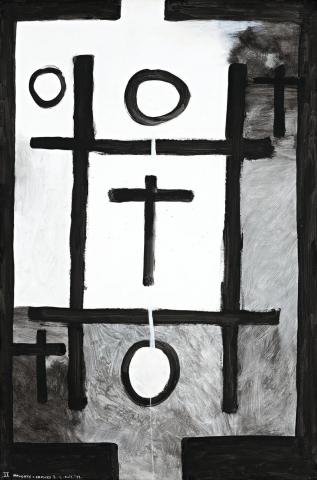NOUGHTS AND CROSSES, SERIES 2, NO. 2, 1976
COLIN McCAHON
synthetic polymer paint on Steinbach paper
110.5 x 73.0 cm
signed with initials, dated and inscribed lower left: II NOUGHTS & CROSSES 2. C. McC. '76.
Peter McLeavey Gallery, Wellington
Private collection, New Zealand, acquired from the above in 1978
Peter McLeavey Gallery, Wellington
Private collection, Brisbane, acquired from the above in 2001
Colin McCahon: Paintings – Noughts and crosses, Rocks in the sky, On the road, Barry Lett Galleries, Auckland, 23 August – 3 September 1976, cat. 2 (as 'Noughts and Crosses (second set)')
Colin McCahon: Necessary Protection: the catalogue of a travelling exhibition of paintings from Colin McCahon's various series from 1971 to 1976, Govett-Brewster Art Gallery, New Plymouth, 1–25 September 1977; Manawatu Art Gallery, Palmerston North, 5–30 October 1977; Robert McDougall Art Gallery, Christchurch, 8 November – 4 December 1977; Dunedin Public Art Gallery, Dunedin, 14 December 1977 – 8 January 1978; Sarjeant Gallery, Wanganui, 18 January – 12 February 1978; National Art Gallery, Wellington, 22 February – 19 March 1978; Hawkes Bay Art Gallery and Museum (Inc.), Napier, 29 March – 23 April 1978; Gisborne Museum and Art Centre, Gisborne, 3–28 May 1978; Waikato Art Museum, Hamilton, 12 July – 6 August 1978; cat. 21 (as 'Noughts & Crosses II 2')
On loan to Art Gallery of New South Wales, Sydney (label attached verso)
McCahon's 'Necessary Protection', Govett-Brewster Art Gallery, New Plymouth, 1977, p. 42, cat. 21 (illus. p. [33])
Bloem, M., and Browne, M., Colin McCahon: A Question of Faith, Craig Potton Publishing & Stedelijk Museum, Amsterdam, 2002, p. 261
Colin McCahon Online Catalogue, www.mccahon.co.nz, ref. cm001171
One of the great masters of twentieth century painting, Colin McCahon is widely revered for his prophetic vision which imbues the vernacular with universal significance to powerfully interrogate sacred questions of faith and doubt, life and death, meaning and despair. Yet while McCahon invariably draws inspiration from the most mundane objects and events in his spiritual quest, the original sources for his meditations are rarely self-evident from the works themselves. Rather it is the existential situation that emerges from the artist's response to this impetus - his reflection distilled through the alchemy of time, memory and recollection - that is immortalised in the sublime incarnations constituting his remarkable legacy.
As with several themes from this decade influenced by the minutiae of the artist's daily life at Muriwai, the inspiration for the Noughts and Crosses series came to McCahon while watching his daughter Victoria play games of noughts and crosses with her young son Tui. As Martin Browne elucidates '... In their discarded scraps of paper, McCahon discovered a rich metaphor for the universal "game" of life. For in life, as in noughts and crosses, each individual must play within a given set of rules, the choices made and chances taken determining what follows thereafter ... Accordingly, now the crosses represented both a positive and affirmative act and, through the metaphor of the Crucifixion, the promise of redemption. As well as the "x" traditionally marking the "cross" in the game, McCahon employs the shape of the Latin Cross - "T" - the Cross of Christ's Crucifixion. By contrast, the noughts here threaten the possibility of the abyss; a primordial void from which there is no hope of escape.'1
Exploiting the brutal intellectual and spiritual implications of this seemingly innocent children's game, McCahon thus embarked upon the acclaimed Noughts and Crosses series which, comprising fourteen paintings (another reference to the numerical symbology of the Stations of the Cross) is divided into two sets of seven known as 'the first set' and 'series 2'. While each of 'the first set' depicts two completed games and common to all but one is the victory of the crosses, in series two, the imagery is reduced to single games whose results become far more ambiguous. Now only the present work and no. 3 repeat the victory of the Latin Crosses that so distinguished the first series. Furthermore, although technically a 'win', the fact that two of the three black crosses in the work on offer are almost obfuscated within the dark background smoke from a fiery hell visibly portends the doubt and despair to follow. Indeed, in paintings no. 4 and 5, the results are inconclusive; in no. 6 the victory of the crosses is rendered with a line of black 'x's rather than the Latin Cross employed previously; while finally, in no. 7, the last painting of the series, the hope offered by the Latin Cross has been completely extinguished, the crosses here appearing in black against a black background while victory lies with the noughts.
Despite such an ostensibly pessimistic finale, the Noughts and Crosses series remains compelling for the beauty, mystery and sophistication with which the artist transforms the everyday into the wonder of an authentic spiritual encounter. For, as with the best of McCahon's work, 'it is the existential situation that prevails ... The viewer is asked to stand with the artist, in a situation where each person must decide the issue in their own way ... It is art used to give the conflict of faith and doubt coherence of thought, effort and expression in its most positive form.'2
1. Bloem, M., and Browne, M., Colin McCahon: A Question of Faith, Craig Potton Publishing & Stedelijk Museum, Amsterdam, 2002, p. 226
2. Brown, G.H., Colin McCahon: Artist, A.H. & A.W. Reed, Wellington, 1984, pp. 117-118
VERONICA ANGELATOS
